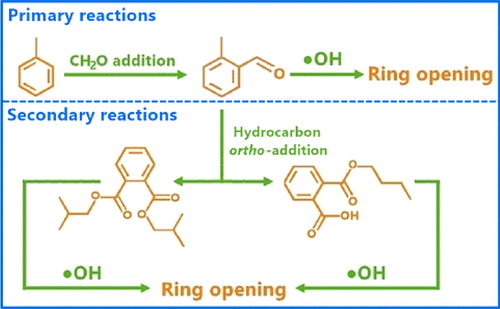当前位置:
X-MOL 学术
›
ACS Catal.
›
论文详情
Our official English website, www.x-mol.net, welcomes your
feedback! (Note: you will need to create a separate account there.)
Synergistic Photocatalytic Decomposition of a Volatile Organic Compound Mixture: High Efficiency, Reaction Mechanism, and Long-Term Stability
ACS Catalysis ( IF 11.3 ) Pub Date : 2020-06-09 , DOI: 10.1021/acscatal.0c00693 Jieyuan Li 1 , Ruimin Chen 2 , Wen Cui 1, 3 , Xing’an Dong 1 , Hong Wang 1 , Ki-Hyun Kim 4 , Yinghao Chu 5 , Jianping Sheng 1 , Yanjuan Sun 1 , Fan Dong 1
ACS Catalysis ( IF 11.3 ) Pub Date : 2020-06-09 , DOI: 10.1021/acscatal.0c00693 Jieyuan Li 1 , Ruimin Chen 2 , Wen Cui 1, 3 , Xing’an Dong 1 , Hong Wang 1 , Ki-Hyun Kim 4 , Yinghao Chu 5 , Jianping Sheng 1 , Yanjuan Sun 1 , Fan Dong 1
Affiliation

|
Photocatalysis technology has been extensively applied for the treatment of volatile organic compounds (VOCs) commonly based on the performance evaluation against a single target component. However, in real situations, a multitude of VOCs are present simultaneously. Other than the studies with photocatalyst design, the mechanisms of mutual effects between different VOCs and the complex reactions at the pollutants/photocatalyst interface are highly delicate to seek for the optimal routes for their decomposition and mineralization. In this work, a comprehensive analysis was made for the destruction of the formaldehyde (CH2O) and toluene (C7H8) mixture. The synergistic efficiency in the decomposition of the CH2O/C7H8 mixture was first established relative to its individual component. The photocatalytic efficiency was maintained for 8 h on the SnO2 photocatalyst, and the durability of the proposed photocatalyst was stable enough even after 30 days of exposure to air. Direct evidence for the synergistic effect on the destruction of the CH2O/C7H8 mixture composition is hypothesized. Most likely, the addition of CH2O into C7H8 turns out to be the rate-determining step in the ring-opening process to promote the decomposition reaction rates for the mixture. It was revealed by gas chromatography–mass spectrometry and density functional theory calculations that the CH2O addition leads to the generation of o-tolualdehyde as key intermediates, which elevated the adsorption and activation of the aromatic ring. This work may offer better insights into the practicality of photocatalysis technology in decomposition of key gaseous pollutants by endowing the “conventional” SnO2 photocatalyst with novel applications.
中文翻译:

挥发性有机化合物混合物的协同光催化分解:高效,反应机理和长期稳定性
通常基于对单个目标组分的性能评估,光催化技术已广泛应用于挥发性有机化合物(VOC)的处理。但是,在实际情况下,会同时存在大量VOC。除了进行光催化剂设计方面的研究之外,不同VOC之间的相互影响机制以及污染物/光催化剂界面处的复杂反应的机理也非常微妙,以寻找其分解和矿化的最佳途径。在这项工作中,对甲醛(CH 2 O)和甲苯(C 7 H 8)混合物的破坏进行了综合分析。CH 2 O / C 7分解的协同效率首先建立相对于其各个组分的H 8混合物。在SnO 2光催化剂上保持8 h的光催化效率,所提出的光催化剂的耐久性甚至在暴露于空气30天后也足够稳定。假设对破坏CH 2 O / C 7 H 8混合物组成具有协同作用的直接证据。最有可能在C 7 H 8中添加CH 2 O事实证明,这是开环过程中提高混合物分解反应速率的决定速率的步骤。气相色谱-质谱和密度泛函理论计算表明,CH 2 O的添加导致邻甲苯甲醛作为关键中间体的产生,从而提高了芳环的吸附和活化。通过将“常规” SnO 2光催化剂赋予新的应用,这项工作可能会为光催化技术在分解关键气体污染物中的实用性提供更好的见解。
更新日期:2020-07-02
中文翻译:

挥发性有机化合物混合物的协同光催化分解:高效,反应机理和长期稳定性
通常基于对单个目标组分的性能评估,光催化技术已广泛应用于挥发性有机化合物(VOC)的处理。但是,在实际情况下,会同时存在大量VOC。除了进行光催化剂设计方面的研究之外,不同VOC之间的相互影响机制以及污染物/光催化剂界面处的复杂反应的机理也非常微妙,以寻找其分解和矿化的最佳途径。在这项工作中,对甲醛(CH 2 O)和甲苯(C 7 H 8)混合物的破坏进行了综合分析。CH 2 O / C 7分解的协同效率首先建立相对于其各个组分的H 8混合物。在SnO 2光催化剂上保持8 h的光催化效率,所提出的光催化剂的耐久性甚至在暴露于空气30天后也足够稳定。假设对破坏CH 2 O / C 7 H 8混合物组成具有协同作用的直接证据。最有可能在C 7 H 8中添加CH 2 O事实证明,这是开环过程中提高混合物分解反应速率的决定速率的步骤。气相色谱-质谱和密度泛函理论计算表明,CH 2 O的添加导致邻甲苯甲醛作为关键中间体的产生,从而提高了芳环的吸附和活化。通过将“常规” SnO 2光催化剂赋予新的应用,这项工作可能会为光催化技术在分解关键气体污染物中的实用性提供更好的见解。











































 京公网安备 11010802027423号
京公网安备 11010802027423号